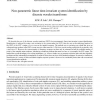Free Online Productivity Tools
i2Speak
i2Symbol
i2OCR
iTex2Img
iWeb2Print
iWeb2Shot
i2Type
iPdf2Split
iPdf2Merge
i2Bopomofo
i2Arabic
i2Style
i2Image
i2PDF
iLatex2Rtf
Sci2ools
DSP
2006
2006
Non-parametric linear time-invariant system identification by discrete wavelet transforms
We describe the use of the discrete wavelet transform (DWT) for non-parametric linear time-invariant system identification. Identification is achieved by using a test excitation to the system under test (SUT) that also acts as the analyzing function for the DWT of the SUT's output, so as to recover the impulse response. The method uses as excitation any signal that gives an orthogonal inner product in the DWT at some step size (that cannot be 1). We favor wavelet scaling coefficients as excitations, with a step size of 2. However, the system impulse or frequency response can then only be estimated at half the available number of points of the sampled output sequence, introducing a multirate problem that means we have to `oversample' the SUT output. The method has several advantages over existing techniques, e.g., it uses a simple, easy to generate excitation, and avoids the singularity problems and the (unbounded) accumulation of round-off errors that can occur with standard...
| Added | 11 Dec 2010 |
| Updated | 11 Dec 2010 |
| Type | Journal |
| Year | 2006 |
| Where | DSP |
| Authors | Robert Wing Pong Luk, Robert I. Damper |
Comments (0)

